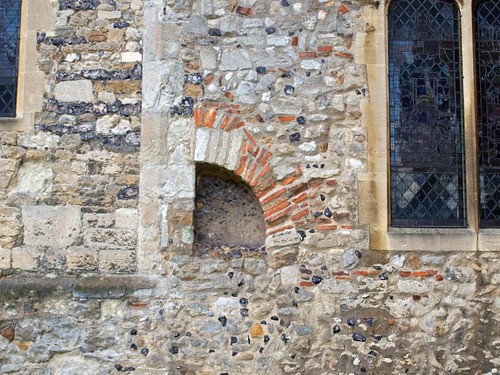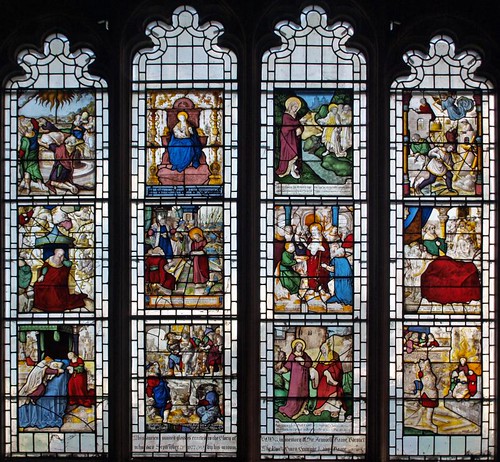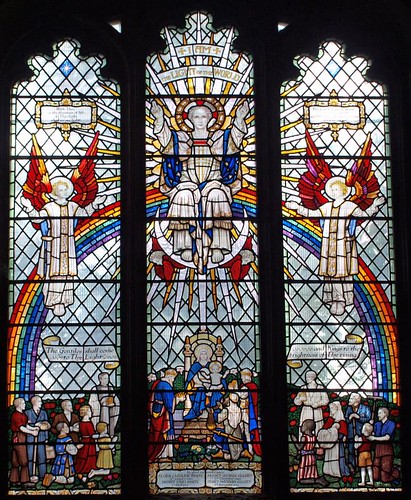ANNUNCIATION OF THE BLESSED VIRGIN MARY. Large church, standing, with quite a lot of space all round, in a position which during the late C19 and C20 lost all its character. Originally its place was just S of the Priory, a place frequently chosen for the parish church, where a monastery dominated a town or village. The church has a large W tower with diagonal buttresses in three set-offs, a W door with shields in the spandrels, a three-light W window with niches to the l. and r., three-light bell-openings, and battlements with flint and stone chequer decoration. The same decoration on the battlements of the nave N wall, chancel and S aisle walls and the two-storeyed S porch. The S aisle windows are big, of three lights; Late Perp. On the N side the nave clerestory is visible and close to the E end, where the chancel starts, a part of a Norman arch with Roman brick voussoirs. It is also visible inside. Other Norman evidence is the two small blocked windows which now appear above the arcade in the S aisle. They were once the nave S windows. On entering the building the surprising thing is that so prosperous a church should have no N aisle. This lop-sidedness remains a little disturbing. The S aisle arcade of eight bays consists of a W portion of three bays, with heavy octagonal piers without proper capitals - the Norman wall just pierced - then three bays of the late C15 with slimmer octagonal piers with concave sides and arches with one wavy and one hollow-chamfered moulding, and then the two bays of the S chancel chapel of similar design and date. - FONT. Perp, octagonal, with concave sides with roses, crossed spears, etc. - DOOR. Early C16, with panels with blank crocketed ogee arches. - COFFER. Remains of an ornately traceried C14 front of a coffer. - STAINED GLASS. South aisle, E window. C16; stories, German or Swiss. - PLATE. Large Cup of 1668.
PRITTLEWELL. Its tiny group of fishermen’s huts at the south end have grown in a hundred years into the greatest Southend of all, the Londoner’»s seaside, a crowded pleasure place, noisy and happy as a medieval fair ground, but with nothing else from those days until we come to Prittlewell, a mile from the wide open mouth of the Thames.
Here a medieval church stands high at the cross-roads in company with a few odd little cottages, and in a lovely garden to the north of it is the priory and now serving Southend as a treasure-house. The church was here before the priory, for in its chancel wall is an arch built of Roman tiles by a Saxon mason. The Normans and their heirs re-shaped the vast building, and some time about 1470 stone was quarried in Kent for the magnificent tower; it is strong enough still to bear the swing of ten bells, one weighing nearly a ton. Flintwork adorns the top of the tower and the two-storeyed porch, where a 400-year-old door with 20 rich panels and its old iron ring opens on to a 13th century arcade pierced in the original Norman wall. The arcade ends in slender Tudor arches replacing those which once held up a central tower and making the nave now 100 feet long. Tudor masons cut the font with roses and pomegranates, and about the same time a Flemish craftsman carved the two panels framed on the wall, one showing winged beasts with necks entwined; they probably once formed part of a chest. Close by is the stone coffin lid of a 13th century priest.
Painted glass, old and new, adds to its beauty. Above the chapel altar are 20 vivid Bible scenes brought from Rouen and Italy. One showing the Temptation is thought to be by Albert Durer; another shows the three men in a realistic fiery furnace. A lovely modern window close by portrays two bishops over 1300 years apart - Cedd, who brought the Good News to Eastern England, and John Watts-Ditchfield, the first Bishop of Chelmsford, who is still recalled with special affection in the slums of East London. Galahad and King Arthur, St Michael and St George, appear as small glowing figures in the porch.
The church was given to the priory which Robert FitzSweyn founded in early Norman times, and eight centuries later the priory with its 35 acres of garden was given to the town by Mr R. A. Jones, who now rests in the cloister with the monks whose ancient home he lived in and restored. Today their home and his is, open to all. We may wander by the River Prittle and come upon the old fishponds, and here is a 13th century wall, all that remains of the church the monks worshipped in; though its foundations prove it to have been 180 feet long with great transepts flanking a central tower. The refectory on the opposite side of the cloister has mostly been built up again, but still retains one Norman wall with one Norman window standing out among the rest, and with a doorway still beautiful, though it has needed much patching since the prior first stopped on his way through it nearly 800 years ago to admire the deep mouldings and the leafy capitals. There are beams in the refectory roof 500 years old, and glowing in its windows are modern shields of all who have made their home here down the centuries. Illuminated manuscripts are in cases and frames, and behind a Jacobean altar rail is the memorial to 1350 men of Southend who fell in the Great War.
Passing into the Prior’s House on the west side of the cloister we first come to two vaulted 15th century rooms, the first containing part of the lead coffin in which some Roman was buried near the park, a Norman coffin lid, and many a stone from the priory church; the second with some worn timbers from Rayleigh Castle, the home of the priory’s founder. Over these vaulted chambers is the timber-framed room where the priors lived and worked, a beautiful room, with the smoke of their fires still left on the magnificent 15th century roof of five bays with two original kingposts. The 16th century put in the fireplace here today, and here is furniture made in the lifetime of the last prior and three things from the end of his story - the seal he had to give up and two documents transferring his priory to avaricious courtiers. The first is a letter from Henry the Eighth, with his portrait and part of the royal seal, granting the priory to Thomas Audley; the second bears the portrait of the boy king Edward and transfers the property to Lord Rich; both documents are superb examples of penmanship.
As we stand where he stood for the last time, looking down on the quiet of the cloister, we can hardly resist a feeling of pity for Thomas Norwich, who saw his priory become the loot of the king and his favourites. Rooms added by later owners are now filled with treasures from the Stone Age onward, and so arranged that we can walk up the corridors of time, past Stone and Bronze Age implements, past a skull 4000 years old, past net-sinkers and loom weights of the Iron Age, Samian ware and Roman coins, pagan swords and a garnet set in gold by Christian Saxons, past weapons and household oddments of the last ten centuries to our own time.
Another beautiful structure which survived in this place is Porters, a red brick house with gabled wings which grew up in the 16th and 17th centuries and still keeps its panelled rooms, the hall with linenfold and carvings of kings, with great beams in the roof and an Elizabethan stone fireplace carved with masks and acanthus leaves. With this house, the priory, and the noble church, Southend’s mother village can still draw the crowds away from the sea to wander for an hour or so in another world.
Here a medieval church stands high at the cross-roads in company with a few odd little cottages, and in a lovely garden to the north of it is the priory and now serving Southend as a treasure-house. The church was here before the priory, for in its chancel wall is an arch built of Roman tiles by a Saxon mason. The Normans and their heirs re-shaped the vast building, and some time about 1470 stone was quarried in Kent for the magnificent tower; it is strong enough still to bear the swing of ten bells, one weighing nearly a ton. Flintwork adorns the top of the tower and the two-storeyed porch, where a 400-year-old door with 20 rich panels and its old iron ring opens on to a 13th century arcade pierced in the original Norman wall. The arcade ends in slender Tudor arches replacing those which once held up a central tower and making the nave now 100 feet long. Tudor masons cut the font with roses and pomegranates, and about the same time a Flemish craftsman carved the two panels framed on the wall, one showing winged beasts with necks entwined; they probably once formed part of a chest. Close by is the stone coffin lid of a 13th century priest.
Painted glass, old and new, adds to its beauty. Above the chapel altar are 20 vivid Bible scenes brought from Rouen and Italy. One showing the Temptation is thought to be by Albert Durer; another shows the three men in a realistic fiery furnace. A lovely modern window close by portrays two bishops over 1300 years apart - Cedd, who brought the Good News to Eastern England, and John Watts-Ditchfield, the first Bishop of Chelmsford, who is still recalled with special affection in the slums of East London. Galahad and King Arthur, St Michael and St George, appear as small glowing figures in the porch.
The church was given to the priory which Robert FitzSweyn founded in early Norman times, and eight centuries later the priory with its 35 acres of garden was given to the town by Mr R. A. Jones, who now rests in the cloister with the monks whose ancient home he lived in and restored. Today their home and his is, open to all. We may wander by the River Prittle and come upon the old fishponds, and here is a 13th century wall, all that remains of the church the monks worshipped in; though its foundations prove it to have been 180 feet long with great transepts flanking a central tower. The refectory on the opposite side of the cloister has mostly been built up again, but still retains one Norman wall with one Norman window standing out among the rest, and with a doorway still beautiful, though it has needed much patching since the prior first stopped on his way through it nearly 800 years ago to admire the deep mouldings and the leafy capitals. There are beams in the refectory roof 500 years old, and glowing in its windows are modern shields of all who have made their home here down the centuries. Illuminated manuscripts are in cases and frames, and behind a Jacobean altar rail is the memorial to 1350 men of Southend who fell in the Great War.
Passing into the Prior’s House on the west side of the cloister we first come to two vaulted 15th century rooms, the first containing part of the lead coffin in which some Roman was buried near the park, a Norman coffin lid, and many a stone from the priory church; the second with some worn timbers from Rayleigh Castle, the home of the priory’s founder. Over these vaulted chambers is the timber-framed room where the priors lived and worked, a beautiful room, with the smoke of their fires still left on the magnificent 15th century roof of five bays with two original kingposts. The 16th century put in the fireplace here today, and here is furniture made in the lifetime of the last prior and three things from the end of his story - the seal he had to give up and two documents transferring his priory to avaricious courtiers. The first is a letter from Henry the Eighth, with his portrait and part of the royal seal, granting the priory to Thomas Audley; the second bears the portrait of the boy king Edward and transfers the property to Lord Rich; both documents are superb examples of penmanship.
As we stand where he stood for the last time, looking down on the quiet of the cloister, we can hardly resist a feeling of pity for Thomas Norwich, who saw his priory become the loot of the king and his favourites. Rooms added by later owners are now filled with treasures from the Stone Age onward, and so arranged that we can walk up the corridors of time, past Stone and Bronze Age implements, past a skull 4000 years old, past net-sinkers and loom weights of the Iron Age, Samian ware and Roman coins, pagan swords and a garnet set in gold by Christian Saxons, past weapons and household oddments of the last ten centuries to our own time.
Another beautiful structure which survived in this place is Porters, a red brick house with gabled wings which grew up in the 16th and 17th centuries and still keeps its panelled rooms, the hall with linenfold and carvings of kings, with great beams in the roof and an Elizabethan stone fireplace carved with masks and acanthus leaves. With this house, the priory, and the noble church, Southend’s mother village can still draw the crowds away from the sea to wander for an hour or so in another world.



No comments:
Post a Comment